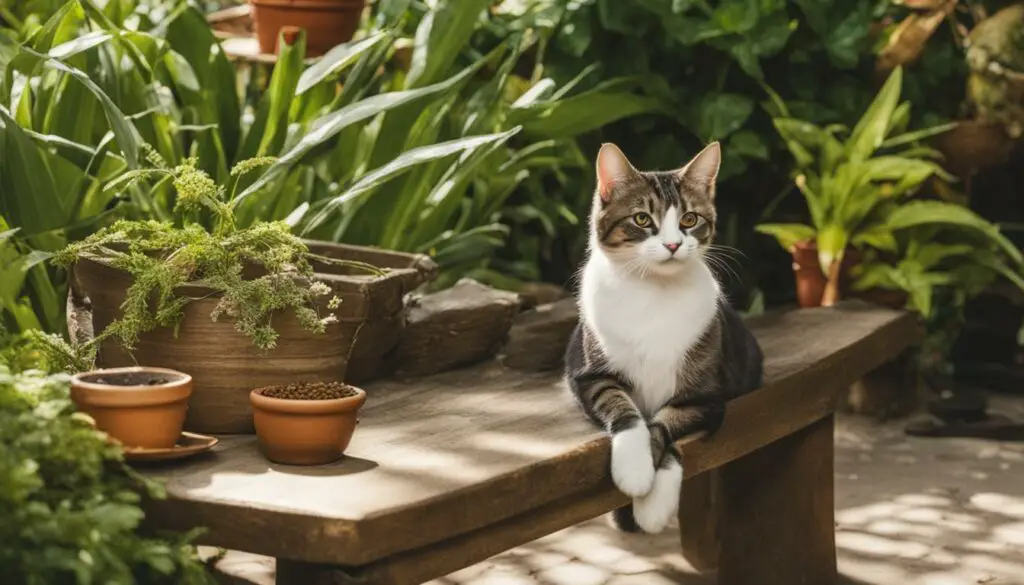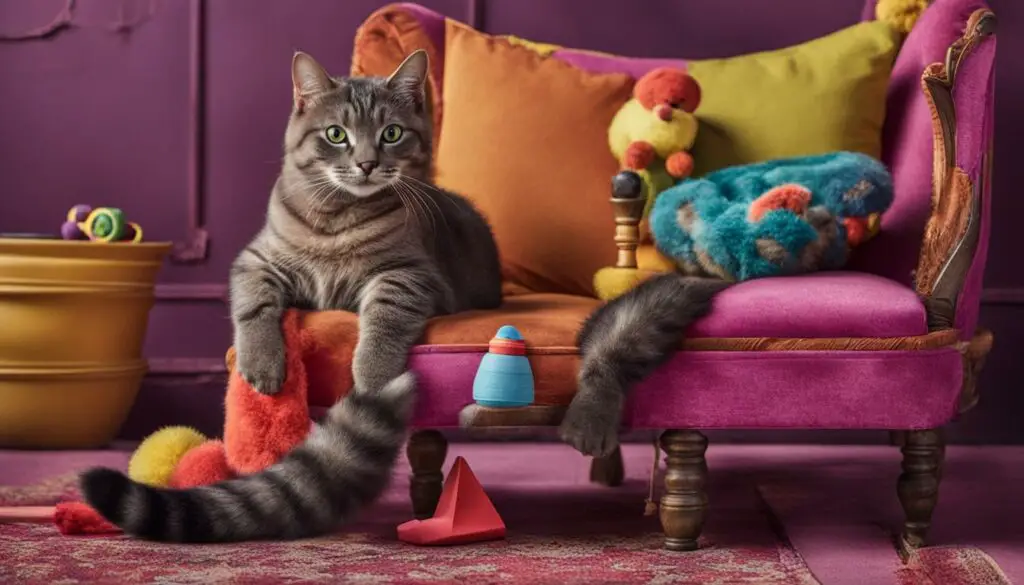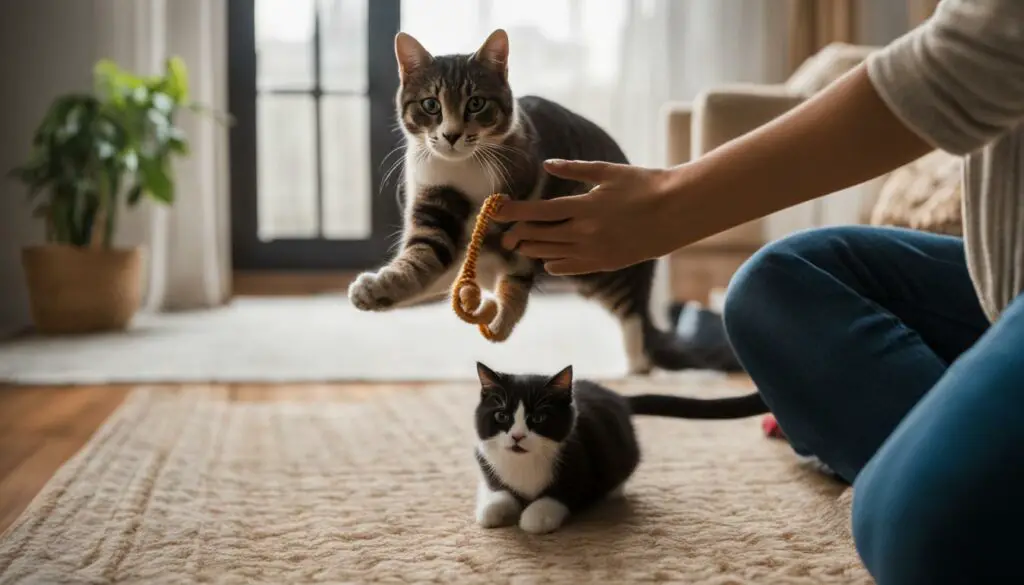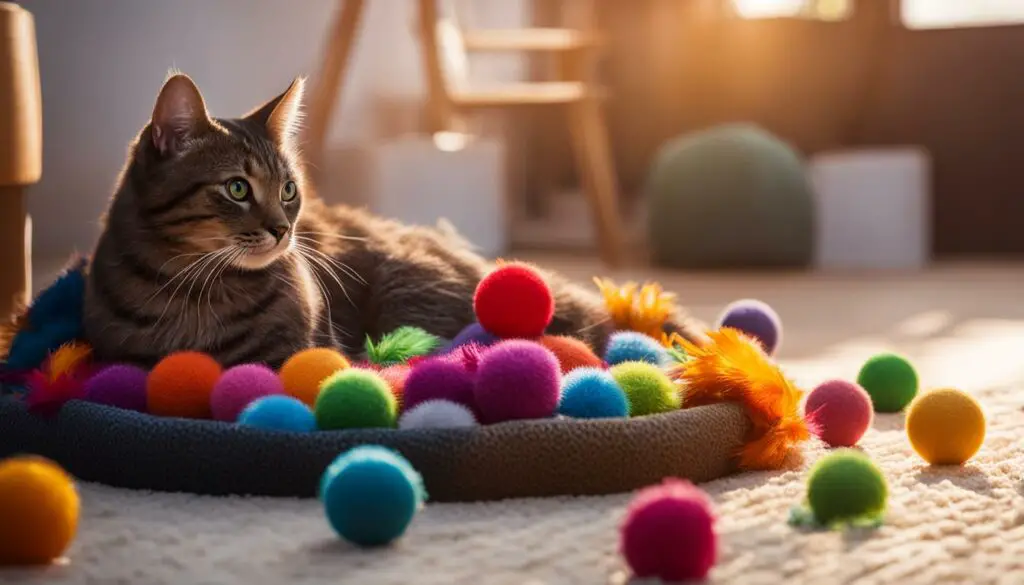Cats can be mysterious creatures, but with the right approach, you can enhance your bond with them. Marilyn Krieger, certified cat behavior consultant, suggests that a cat’s behavior is often influenced by what people do or don’t do. By following expert tips, you can make a cat feel comfortable and secure, and create a positive interaction.
Key Takeaways:
- Watch your body language and make yourself appear smaller and less intimidating
- Let the cat approach you and take it slow
- Observe the cat’s likes and dislikes and cater to their preferences
- Stay calm and positive to create a comfortable environment
- Use treats strategically to reward good social interactions
Watch Your Body Language
When approaching a cat for the first time, it’s important to be mindful of your body language. Cats are highly perceptive animals and can interpret our movements and gestures. To make a cat feel safe and secure, it is recommended to crouch down to appear smaller and less intimidating. Avoid direct eye contact, as this can be seen as aggressive behavior. Instead, position your body and attention away from the cat, allowing them to approach you at their own pace.

By playing hard to get and giving the cat the choice to approach you, you are establishing a sense of trust and comfort. This allows the cat to feel more in control of the interaction, promoting a positive experience for both of you. Remember, cats have their own unique personalities and preferences, so it’s essential to be patient and respectful of their boundaries.
Watch Your Movements
When interacting with a cat, it’s crucial to be mindful of your movements. Avoid sudden or jerky motions, as these can startle or frighten a cat. Instead, move slowly and deliberately, giving the cat time to adjust to your presence. Cats are also sensitive to loud noises, so try to keep a calm and quiet environment. This will help the cat feel more relaxed and at ease during the interaction.
| Cat Body Language | Meaning |
|---|---|
| Tail up and curved at the end | Relaxed and happy |
| Arched back, puffed-up tail, and ears flattened | Fearful or aggressive |
| Tail swipe | Agitated or annoyed |
| Tail twitching | Excited or irritated |
Understanding cat body language can provide valuable insights into their mood and comfort level. By paying attention to their tail, ears, and overall body posture, you can adjust your approach and interactions accordingly.
Let the Cat Approach You
When it comes to approaching a cat, it’s important to remember that they are independent creatures who prefer to set their own boundaries. By allowing the cat to come to you, you can create a safer and more comfortable environment for both of you. Here are some tips on how to let the cat approach you:
- Crouch down or sit on the floor: By lowering yourself to the cat’s level, you appear less threatening and more approachable.
- Extend your finger for the cat to sniff: Offering your finger gives the cat a chance to familiarize themselves with your scent and initiate contact if they feel comfortable.
- Take it slow: Patience is key when interacting with cats. Allow the cat to set the pace of the interaction and don’t rush them.
- Give them space: Respect the cat’s personal space and avoid crowding them. This gives them the freedom to relax and establish their comfort level.
By following these tips, you can create a positive and safe interaction with a cat. Remember, every cat is unique, so it’s important to be patient and let them approach you on their own terms.

Why Letting the Cat Approach You is Important
Allowing the cat to approach you has several benefits. Firstly, it gives them a sense of control and autonomy, which helps them feel more at ease. By approaching on their own terms, they are more likely to feel safe and comfortable in your presence. Secondly, approaching a cat too forcefully or quickly can trigger their flight or fight response, leading to stress and potential aggression. By letting the cat take the lead, you are minimizing the risk of negative reactions and creating a positive experience for both of you.
In conclusion, letting the cat approach you is a key element in building a bond and creating a safe and positive interaction. By crouching down, offering your finger, and giving them space, you are fostering an environment of trust and respect. Remember to be patient and let the cat set the pace. With time and patience, you can establish a strong and rewarding relationship with your feline companion.
Cat Socializing Techniques: Gaining a Cat’s Trust
Gaining a cat’s trust is an essential step in building a strong bond and creating a positive relationship. Each cat has its own unique personality and preferences, so it’s important to observe their behaviors and adjust your approach accordingly. Here are some effective cat socializing techniques that can help you earn a cat’s trust and establish a lasting connection:
1. Patience and Respect
Approaching a cat with patience and respect is key. Avoid making sudden movements or loud noises that can startle them. Allow the cat to approach you at their own pace and avoid forcing interactions. By giving them space and time to feel comfortable, you show them that you respect their boundaries.
2. Slow and Gentle Approach
A slow and gentle approach is crucial when trying to gain a cat’s trust. Crouch down to their level and extend a hand for them to sniff. Avoid reaching out to pet them directly, as it may feel threatening to them. Let the cat initiate physical contact and always be gentle in your touch.
| Cat Socializing Technique | Key Takeaway |
|---|---|
| Patience and Respect | Show respect for the cat’s boundaries and give them time to feel comfortable. |
| Slow and Gentle Approach | Approach the cat slowly and let them initiate physical contact. |
| Positive Reinforcement | Reward the cat with treats and praise for their desired behaviors. |
| Playtime and Mental Stimulation | Engage in playtime to build trust and provide mental stimulation. |
3. Positive Reinforcement
Using positive reinforcement techniques can help a cat associate you with pleasant experiences. Offer them treats and praise when they display desired behaviors, such as approaching you or allowing gentle petting. This positive reinforcement helps them build trust and reinforces their confidence in interacting with you.
4. Playtime and Mental Stimulation
Engaging in playtime with your cat not only provides mental stimulation but also helps in building trust and strengthening your bond. Use interactive toys, such as wand toys or puzzle feeders, to keep them engaged and excited. Pay attention to their body language and respect their boundaries during playtime.
Gaining a cat’s trust takes time and patience. By approaching them with respect, honoring their boundaries, and using positive reinforcement techniques, you can create a safe and loving environment for both you and your feline friend.

Cat Handling Methods for Safe and Positive Interactions
When it comes to handling cats, it’s important to approach them with care and respect. By using proper cat handling methods, you can ensure their safety and create a positive interaction. Here are some tips to help you handle cats in a way that makes them feel comfortable and secure:
- Approach with a calm demeanor: Cats are sensitive to sudden movements and loud noises. Approach them slowly and calmly, avoiding any abrupt gestures that may startle them.
- Support their body: When picking up a cat, make sure to support their body properly. Place one hand under their chest and the other hand supporting their hindquarters. This will help them feel secure and prevent any unnecessary stress or discomfort.
- Respect their boundaries: Cats have personal space preferences, just like humans. Pay attention to their body language and cues. If they show signs of discomfort or aggression, give them space and avoid forcing any interaction.
“Approaching a cat with gentleness and respect is key to building trust and creating a strong bond. By understanding their needs and boundaries, we can ensure a safe and positive interaction for both humans and cats.” – Marilyn Krieger
Remember to always observe the cat’s behavior and respond accordingly. Each cat is unique and may have different comfort levels and preferences. By being mindful of their needs and using appropriate handling techniques, you can create a trusting relationship with your feline friend.
Table: Dos and Don’ts of Cat Handling
| DOs | DON’Ts |
|---|---|
| Approach with a calm demeanor | Reach for the cat abruptly |
| Support their body when picking them up | Grab them by the scruff of the neck |
| Respect their boundaries and personal space | Force any interaction or handling |
| Observe their body language and respond accordingly | Ignore signs of discomfort or aggression |
By following these cat handling methods, you can ensure the safety and well-being of both yourself and the cat. Remember, building trust with a cat takes time and patience. With proper handling techniques, you can establish a strong bond and create a harmonious relationship with your furry companion.

Use Treats Strategically
Gaining a cat’s trust can be a delicate process, but one effective method is to use treats strategically. By offering treats during social interactions, you can reinforce positive behavior and create a stronger bond with your feline friend.
When using treats, it’s important to choose ones that your cat enjoys. Chicken breast, stinky cheese, or tuna flakes are often popular options. Experiment with different treats to find the ones that your cat finds most enticing.
Strategically using treats can help in various situations. If you’re approaching a shy cat, you can use treats to entice them to come closer. Extend your hand with a treat and allow the cat to approach at their own pace. This can help them feel more comfortable and build trust over time.
Additionally, treats can be used as rewards for good behavior. For example, if your cat is displaying positive social interactions, such as rubbing against your legs or purring, you can reinforce this behavior by offering a treat. This positive association will encourage your cat to continue engaging in these desirable behaviors.

Table: Types of Treats to Consider
| Treat Type | Description |
|---|---|
| Chicken Breast | A lean and protein-rich treat that many cats find irresistible. |
| Stinky Cheese | Certain types of cheese, such as blue cheese or feta, have a strong aroma that can be enticing to cats. |
| Tuna Flakes | Tuna flakes are thin and easy to chew, making them a popular choice among cats. |
“Using treats strategically can be a highly effective way to gain a cat’s trust and strengthen your bond with them.”
Remember, treats should be used in moderation and as part of a balanced diet. Consult with your veterinarian to ensure you are selecting treats that are appropriate for your cat’s health and dietary needs. With patience and the right approach, using treats strategically can help you establish a deeper connection with your feline companion.
Be Playful – but Know When To Stop
Playtime is an important aspect of building a bond with your cat. Engaging in playful activities not only provides mental stimulation but also strengthens your relationship. However, it is crucial to understand when to stop and respect your cat’s boundaries.
During playtime, use interactive toys such as wand toys, ball-and-track toys, or puzzle feeders to keep your cat engaged. Observe their body language and make sure they are interested and comfortable. If your cat starts to show signs of fatigue or disinterest, it’s time to wrap up the play session. Overstimulation can lead to stress and may negatively impact your bond.
Remember, each cat has its own play preferences and limits. Some cats enjoy longer play sessions, while others may prefer shorter bursts. It’s essential to pay attention to your cat’s cues and adjust accordingly. By being respectful of their boundaries, you create a safe and enjoyable environment for playtime.
Table: Recommended Playtime Duration for Cats
| Age of the Cat | Recommended Playtime Duration |
|---|---|
| Kitten (under 6 months) | 3-4 sessions of 10-15 minutes each |
| Adult Cat | 2-3 sessions of 10-15 minutes each |
| Senior Cat | 1-2 sessions of 10-15 minutes each |
“Playtime should be a positive experience for both you and your cat. It’s important to pay attention to their cues and stop when they’ve had enough. By being mindful of their limits, you can foster a stronger bond.”
After playtime, provide your cat with a calm and quiet space to relax and recharge. This allows them to decompress and prevents overstimulation. Avoid forcing them to continue playing or engaging in rough play, as it can lead to aggression or fear.
By being playful and knowing when to stop, you can build a strong bond with your cat based on trust and respect. Remember to always prioritize their comfort and well-being during playtime. Happy playing!

Section 8: Create a Feline-Friendly Environment
Creating a feline-friendly environment is essential to ensure the well-being and happiness of your cat. By providing the right resources and setting up a space that meets their natural instincts, you can foster a strong bond and enhance their overall quality of life. Here are some essential cat socializing techniques and cat handling methods to consider:
1. Provide Enrichment
Cats are curious creatures that require mental and physical stimulation. Make sure to offer a variety of toys, scratching posts, and interactive playtime to keep them engaged and entertained. Puzzle feeders can also be a great way to provide mental enrichment and challenge their problem-solving skills.
2. Create Safe Spaces
Cats need a space of their own where they can feel safe and secure. Designate a quiet area in your home as their base camp, complete with cozy beds, hiding spots, and elevated perches. This will give them a sense of ownership and a retreat when they need some alone time.
3. Establish a Routine
Cats thrive on routine, so it’s important to establish consistent feeding, play, and sleep schedules. This helps them feel secure and reduces stress or anxiety. Try to stick to a regular routine as much as possible, even during weekends or vacations.
| Benefits | Examples | |
|---|---|---|
| Scratching posts | Allows cats to stretch, exercise, and mark their territory | Vertical, horizontal, and sisal rope scratching posts |
| Interactive toys | Stimulates mental and physical activity | Puzzle feeders, treat dispensers, and wand toys |
| Cozy hiding spots | Provides a safe and secure space | Cat caves, covered beds, and cardboard boxes |
| Elevated perches | Offers a high vantage point and reduces stress | Window perches, cat trees, and wall-mounted shelves |
“Creating a feline-friendly environment is essential to ensure the well-being and happiness of your cat.”
Remember, each cat is unique, so it’s important to observe their preferences and adjust their environment accordingly. By considering their needs and providing a space that caters to their natural behaviors, you’ll create a harmonious and fulfilling environment for your feline friend.

How to Tell if a Cat Likes You
Building a bond with a cat is a delicate process that requires understanding their body language and interpreting their behaviors. While cats may not express their affection in the same way humans do, there are subtle signs that indicate they like you. By paying attention to these cues, you can strengthen your bond and create a deeper connection with your feline friend.
Signs of Positive Affection
When a cat likes you, they may exhibit several behaviors that signify their positive emotions. Look for these signs:
- Meowing: Cats may vocalize to get your attention or communicate their contentment.
- Purring: A cat’s purr is a clear indication of their happiness and relaxation.
- Rubbing against your legs: This behavior is a way for cats to mark you as part of their territory and show their affection.
- Head butting: When a cat bumps their head against you, it’s a sign of trust and a way to distribute their scent onto you, marking you as safe and familiar.
- Long, slow blinking: Cats often give you a slow blink, also known as a “kitty kiss,” which is a sign of comfort and acceptance.
These behaviors demonstrate that your cat feels comfortable and secure in your presence, which is a positive indication of your bond.

Spending Time Near You and Exposed Abdomen
In addition to the behaviors mentioned above, a cat that likes you will likely spend time near you. They may choose to sit or sleep close by, seeking your company and companionship. This proximity indicates that they feel safe and comfortable with you.
Another sign of trust is when a cat exposes their abdomen to you. This vulnerable area is typically protected, so when a cat shows you their belly, it means they feel secure and relaxed in your presence.
Remember that every cat is unique, and their behaviors may vary. It’s important to observe and understand your cat’s individual preferences and body language to build a strong and mutually rewarding bond.
What About Befriending Homeless Cats?
When it comes to approaching shy or homeless cats, it’s crucial to proceed with caution and respect. These cats may have had difficult experiences or lack socialization, making them fearful of human contact. Instead of attempting to pet or pick up a homeless cat, there are safer and more humane ways to help improve their lives.
One way to befriend a homeless cat is by providing them with food and shelter. Set up a designated feeding station in a quiet area where the cat feels safe. Use dry or wet cat food to entice them and keep a consistent feeding schedule. Additionally, you can offer shelter options such as a sturdy outdoor cat house or a cozy nest lined with blankets.
Working with local animal organizations is another effective way to help homeless cats. These organizations have experience in trapping, neutering, and releasing feral cats (TNR), which helps control the population and ensures the cats’ health. They can also provide guidance and resources for socializing feral cats or finding them suitable homes.
“Approaching shy or homeless cats requires patience, understanding, and a focus on their well-being. By offering food, shelter, and working with local organizations, we can make a positive impact on their lives.”
Remember, gaining the trust of a shy or homeless cat takes time. Some cats may never fully trust humans, but by providing them with essential resources and respecting their boundaries, we can improve their quality of life and contribute to their well-being.
| Approach | Benefits |
|---|---|
| Provide food and shelter | – Helps meet their basic needs – Provides a sense of security – Establishes a routine |
| Work with local organizations | – Access to resources and guidance – Opportunities for socialization or rehoming – Promotes population control |

Additional Tips for Approaching Shy Cats:
- Be patient and allow the cat to approach on their terms.
- Avoid sudden movements and loud noises that may startle them.
- Use soft, reassuring tones when speaking to the cat.
- Offer treats or toys as a positive reinforcement for their presence.
- Respect their personal space and boundaries.
By approaching shy cats with empathy, understanding, and a focus on their well-being, we can make a positive impact on their lives.
What Do Cats Remember?
Cats have incredible memory capabilities, but they are selective in what they remember. They tend to remember experiences that have had a significant impact on them, whether positive or negative. When it comes to building a bond with a cat, it’s crucial to focus on creating positive experiences that shape their behavior and perception of you.
By treating cats with kindness, respect, and understanding, you can establish lasting memories that contribute to a strong and trusting relationship. Cats remember how they have been treated and will respond accordingly. Every interaction counts, so it’s important to approach cats with patience, gentleness, and a calm demeanor.
“Cats remember how they have been treated and will respond accordingly.”
When cats have positive memories associated with you, they are more likely to feel comfortable and secure in your presence. They may express their affection through meowing, purring, rubbing against your legs, or head butting. Slow blinking is also a sign of trust and contentment. These behaviors demonstrate that the cat likes you and enjoys your company.
Remember, gaining a cat’s trust takes time and effort. It’s essential to be consistent in your interactions and to always respect their boundaries. By focusing on creating positive memories, you can build a strong and lasting bond with your feline companion.
Cat Body Language: Tails
Cats have a unique way of communicating their feelings, and their tails play a crucial role in expressing their emotions. Understanding a cat’s tail language can help you interact with them in a safe and respectful manner. Here are some common tail positions and what they indicate:
Tail Straight and Relaxed:
When a cat’s tail is straight and relaxed, it signifies that they are calm and content. This is an ideal tail position to approach a cat and initiate interaction. However, always remember to approach slowly and gently to respect the cat’s boundaries.
Puffed-up Tail:
If a cat’s tail is puffed up, it means they are feeling fearful or aggressive. It’s important to give these cats space and avoid any sudden movements or loud noises that might escalate their stress. Allow them to calm down and feel safe before attempting any interaction.
Tail Twitching:
A twitching tail can indicate irritation or excitement in a cat. This behavior is often seen when a cat is focused on something or ready to pounce. It’s essential to respect their mood and avoid disturbing them during such moments.
Remember, interpreting cat body language is an art that takes time and observation. Each cat may have their unique tail expressions, so it’s crucial to build a relationship with individual cats and understand their specific cues. By paying attention to their tail positions and adjusting your approach accordingly, you can ensure a safe and positive interaction with cats.

Top 10 Working Cats (…with Jobs!)
In addition to being beloved pets, cats can also excel in various roles and perform jobs that are beneficial to humans. These working cats contribute to their communities in unique ways and showcase their skills and abilities.
Here are ten examples of working cats and the jobs they perform:
- Barn Cats: Known for their excellent hunting skills, barn cats help control the rodent population in agricultural settings. They safeguard barns, stables, and other structures from pests.
- Brewery Cats: Found in breweries and distilleries, these cats play a crucial role in keeping grain-eating pests, such as rats and mice, at bay. They protect the stored ingredients and maintain a hygienic environment.
- Library Cats: Libraries are often home to resident cats who provide companionship to staff and visitors while also helping to control potential book-damaging pests like mice and insects.
- Therapy Cats: These cats have a calm and nurturing demeanor, making them perfect for providing emotional support to individuals in hospitals, nursing homes, or other therapeutic settings.
- Police Cats: Some police departments use specially trained cats to detect drugs or explosives. Their exceptional sense of smell and agility make them valuable assets in law enforcement.
- Train Station Cats: In various train stations worldwide, cats serve as mascots and keep watch over the premises. They add charm and character while preventing the presence of rodents.
- Office Cats: Found in workplaces, office cats help create a stress-free environment and boost employee morale. They provide companionship and help reduce anxiety and stress levels.
- Restaurant Cats: Certain restaurants employ cats to control the population of pests such as rats and mice. These cats maintain a pest-free environment while charming patrons with their presence.
- Guard Cats: Guard cats are trained to patrol a specific area, similar to guard dogs. They are vigilant and alert, deterring intruders and ensuring the security of the property.
- Farm Cats: Cats on farms assist in keeping the premises free from pests and vermin. They protect crops, farm animals, and livestock by hunting rodents and other small creatures.
These working cats not only fulfill important roles but also provide companionship, entertainment, and a sense of community. Through their incredible abilities and natural instincts, they demonstrate the unique bond between humans and felines.

Conclusion
So, there you have it! Mastering the art of how to approach a cat is all about understanding their needs and preferences. By following expert tips and observing their body language, you can create a safe and comfortable environment for both you and your feline friend.
Remember, it’s important to let the cat take the lead and approach you at their own pace. Use treats strategically to reinforce positive behavior and be playful, but always respect their boundaries. Building a bond with a cat takes time and patience, but the rewards are worth it.
Whether you’re a cat lover or want to befriend a homeless cat, these best ways to approach a cat will help you establish trust and create meaningful relationships. Cats may be mysterious creatures, but with the right approach and a little love, you can unlock their affectionate nature and enjoy a lifelong companionship.
FAQ
How should I approach a cat for the first time?
Crouch down to appear smaller and less intimidating, avoid direct eye contact, and position your body and attention away from the cat. Allow the cat to approach you and establish a sense of trust and comfort.
What areas should I pet a cat?
Stick to petting the cat on the forehead, neck, cheeks, and around the ears, as these areas are often enjoyed by cats. Observe the cat’s behaviors and learn what they enjoy.
How can I make a cat feel comfortable and secure?
Stay calm and predictable in your actions, reward the cat with treats or toys, and create a positive environment by using their name often. Provide them with a feline-friendly environment that includes scratching posts, cat trees, and interactive toys.
How can I tell if a cat likes me?
Look for meows, purring, rubbing against your legs, head butting, and long, slow blinking. Spending time near you and resting with an exposed abdomen are also signs of trust and closeness. Remember, every cat has different ways of showing affection.
How should I approach a homeless cat?
It’s important to approach homeless cats with caution. Instead of attempting to pet or pick them up, focus on safe, humane ways to improve their lives, such as providing food and shelter or working with local animal organizations.
What do cats remember?
Cats have good long-term memory, but their memory is selective. They remember experiences that are significant to them, such as positive or negative interactions with humans. By treating them with kindness and respect, you can create positive memories that will shape their behavior and perception of you.
How can I interpret a cat’s tail language?
A relaxed, straight tail indicates a calm and content cat. A puffed-up tail indicates fear or aggression, while a twitching tail can mean irritation or excitement. Paying attention to the cat’s tail can help you understand their emotional state and adjust your approach accordingly.
Do cats have jobs?
Yes, cats can be trained to perform various jobs and tasks. From hunting rodents to providing emotional support, cats have unique skills that make them valuable. Examples of working cats include barn cats, brewery cats, and library cats.
Source Links
- https://be.chewy.com/pet-parenting-pet-lovers-how-to-get-a-cat-to-like-you/
- https://www.jacksongalaxy.com/blogs/news/cat-introductions-part-1-before-the-introduction
- https://www.penguinrandomhouse.com/books/588950/how-to-argue-with-a-cat-by-jay-heinrichs-with-illustrations-by-natalie-palmer-sutton/9781635652741/teachers-guide/








